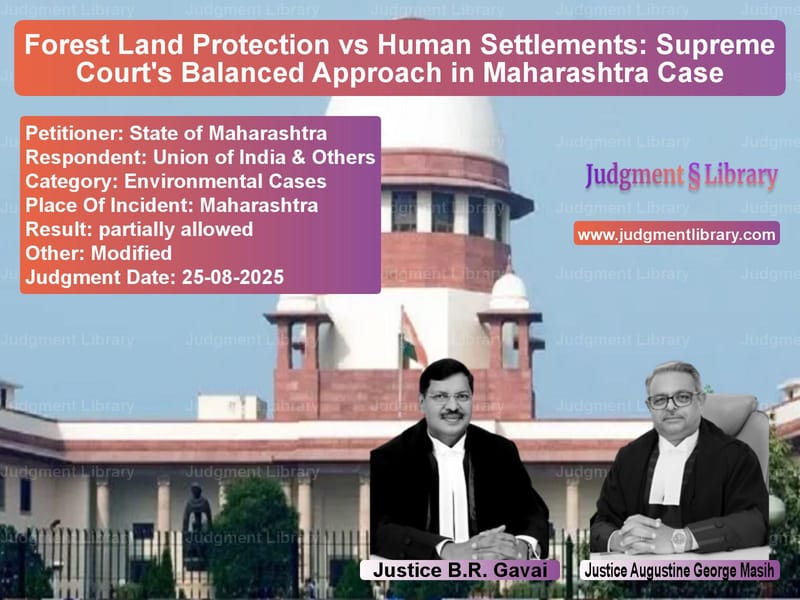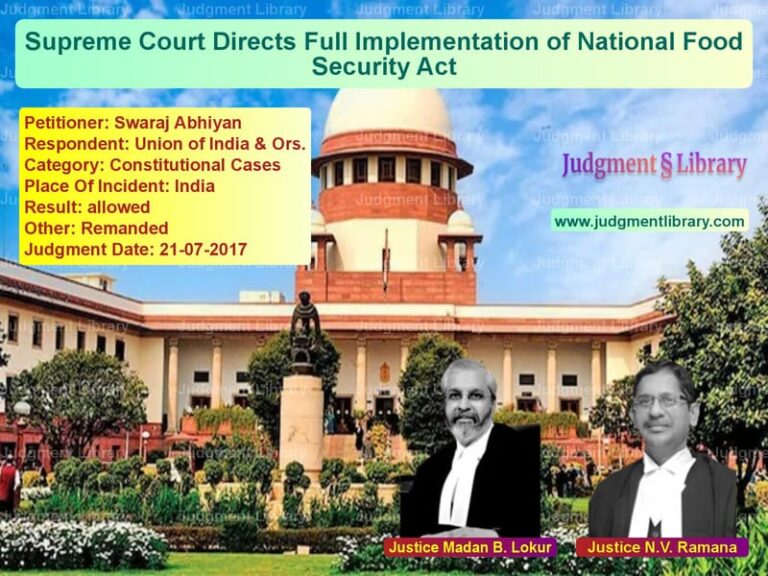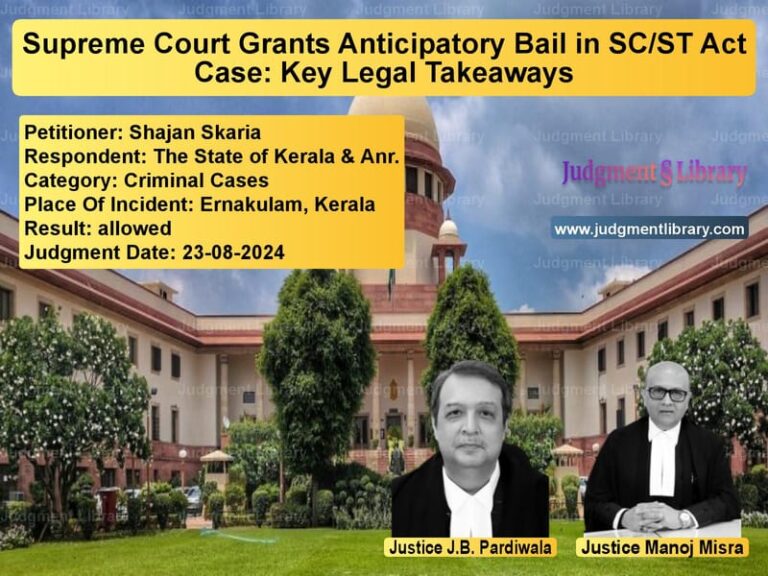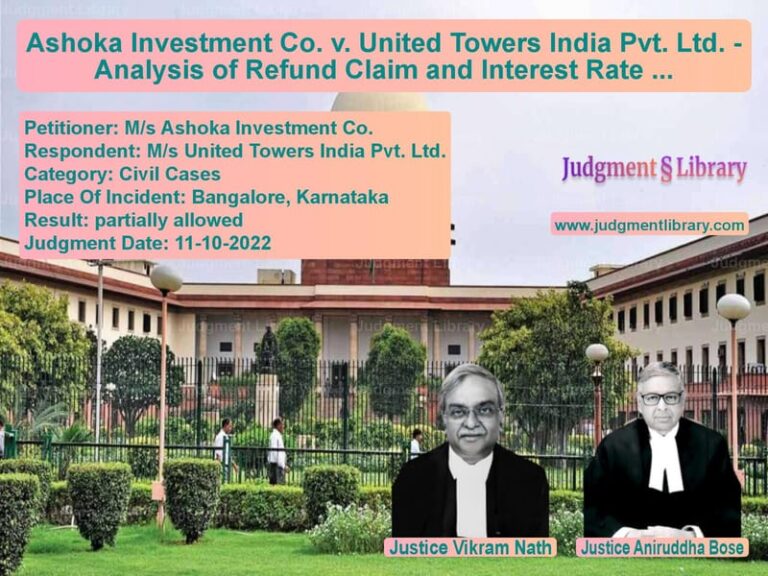Forest Land Protection vs Human Settlements: Supreme Court’s Balanced Approach in Maharashtra Case
In a significant development in India’s long-standing forest conservation litigation, the Supreme Court has delivered a nuanced order that balances environmental protection with the realities of human habitation and development needs. The case, which originates from the famous T.N. Godavarman Thirumulpad forest conservation matter that has been ongoing since 1995, saw the State of Maharashtra approaching the Court seeking modifications to its earlier judgment dated May 22, 2025.
The State’s application raised two crucial issues that affect thousands of hectares of land and potentially millions of people. On one hand, there was the need to protect fragmented forest lands, and on the other, there was the practical reality of existing settlements, schools, government colonies, and agricultural lands that had developed over decades. This presented the classic dilemma of environmental conservation versus human development that courts often grapple with in environmental jurisprudence.
The State of Maharashtra, in its application, made two specific prayers to the Supreme Court. The first prayer sought modification of the direction regarding fragmented land parcels, requesting that instead of being declared as protected forests, these lands measuring less than 3 hectares and not adjoining any forest area could be used for purposes mentioned in the Forest Rights Act, 2006 or other public uses required by villages. The second prayer sought protection for encroachments that were being used for agriculture, houses, schools, and other public utilities covering approximately 10,365 hectares.
The Supreme Court, comprising Chief Justice B.R. Gavai and Justice Augustine George Masih, delivered a mixed verdict that showed both firmness on environmental principles and compassion for human settlements.
The Court’s Ruling on Fragmented Forest Lands
Regarding the first prayer concerning fragmented land parcels, the Supreme Court maintained its environmental stance. The Court rejected the State’s request to modify its earlier direction that these lands be declared as protected forests. The judges were clear that environmental protection couldn’t be compromised, stating: “We are therefore not inclined to accept the prayer clause (i)(a) and reject the same.”
However, showing judicial wisdom, the Court provided a way forward for the State while maintaining environmental safeguards. The Court noted that “it is clear from sub-section (2) of Section 3 of The Scheduled Tribes and Other Traditional Forest Dwellers (Recognition of Forest Rights) Act, 2006 that the provisions therein begin with a non obstante clause.” This observation was crucial because it indicated that the Forest Rights Act contained provisions that could override other laws under specific circumstances.
The Court clarified its position by stating: “Accordingly, with respect to the direction in para 138(vii) of the judgment and order dated 22nd May 2025 is concerned, we direct that all such fragmented land parcels shall be declared as protected forest. We, however, clarify that if the State desires to use the said land for any of the purposes mentioned under sub-Section (2) of Section 3 of the said Act, the same can be done only after following the procedure prescribed therein and subject to fulfillment of the conditions specified therein.”
This balanced approach ensured that while forest protection remained paramount, the State could still utilize these lands for legitimate purposes outlined in the Forest Rights Act, provided it followed the due process established by law.
Protection for Existing Settlements and Public Utilities
The second part of the State’s application dealing with existing encroachments saw a more favorable response from the Court. Here, the Supreme Court recognized the ground realities and the human dimension of the issue. The Court noted that “one of the main reasons why we were inclined to grant a one time exemption was that over the years and on account of apathy of revenue officials, the necessary revenue entries could not be made. For a long period of time, the land under consideration has been used for the purpose of agriculture, kuccha houses, pakka houses, slums, Govt. employees colonies, Govt. or Z.P. Schools, private schools and other public utilities.”
This acknowledgment of administrative failure and the recognition of long-standing usage patterns demonstrated the Court’s understanding of practical governance challenges. The Court also took note of the recommendation from the Central Empowered Committee (CEC), stating: “The Central Empowered Committee (CEC) in its report itself had recommended the protection of such structures to the extent of 10,365.049 hectares.”
Based on these considerations, the Court ruled: “In that view of the matter, we are inclined to allow prayer clause (i)(b).” The Court then provided specific directions by adding a new paragraph (x-a) to its earlier judgment, which stated: “We, however, clarify that the directions made in paragraph (x) would not be applicable to the encroachments made prior to 12th December 1996 for the purposes of agriculture, kuccha houses, pakka houses, slums, govt. employees colonies, govt. or Z.P. Schools, private schools and other public utilities to the extent of 10365.049 hectares, as has been observed in the report of the CEC. Insofar as any encroachment which has been made after 12th December 1996, if the State Government desires to regularize the same, the same shall be done only in accordance with the provisions of clauses (ii) to (vi) of paragraph 138 of this judgment.”
The Significance of the December 12, 1996 Cut-off Date
The Court’s use of December 12, 1996 as the cut-off date for protected encroachments is particularly significant. This date corresponds with the Supreme Court’s initial order in the Godavarman case that effectively stopped all non-forest activities in forest areas without prior approval. By using this date, the Court maintained consistency with its long-standing jurisprudence on forest conservation while providing relief for settlements that existed before this crucial environmental landmark.
This approach shows the Court’s recognition that while environmental protection is crucial, it cannot be implemented in a manner that disregards historical realities and disrupts established communities. The distinction between pre-1996 and post-1996 encroachments creates a fair balance – protecting those who settled in these areas before the forest conservation framework was strengthened, while maintaining strict scrutiny for more recent settlements.
Broader Implications for Forest Conservation and Rights
This judgment represents an important evolution in India’s forest jurisprudence. The Godavarman case, which began in 1995, has been instrumental in shaping India’s forest conservation policies. Over the years, the Supreme Court has issued numerous directions to protect forests, regulate mining, control encroachments, and establish monitoring mechanisms like the Central Empowered Committee.
The current order demonstrates a maturation of this jurisprudence – moving from purely protectionist approaches to more nuanced ones that balance environmental concerns with human needs and rights. The Court’s recognition of the Forest Rights Act, 2006 as a legitimate framework for addressing certain forest land uses marks an important integration of environmental law with tribal and forest dwellers’ rights legislation.
The judgment also underscores the importance of the Central Empowered Committee’s role in forest governance. By relying on the CEC’s recommendations regarding the protection of existing structures, the Court has reinforced the Committee’s technical and advisory role in forest matters.
For the State of Maharashtra, this order provides much-needed clarity on how to handle the complex issue of forest land management. The direction to declare fragmented land parcels as protected forests while allowing for certain uses under the Forest Rights Act creates a clear legal pathway. Similarly, the protection for pre-1996 settlements resolves uncertainty for thousands of families living in these areas while maintaining the legal regime against recent encroachments.
Environmental groups may view the protection of fragmented forests as a positive step, as these smaller forest patches, though fragmented, play crucial ecological roles in maintaining biodiversity, preventing soil erosion, and supporting local ecosystems. At the same time, human rights advocates would appreciate the Court’s recognition of existing settlements and public utilities, preventing large-scale displacement and social disruption.
The order also highlights the continuing challenge of governance and administration in forest areas. The Court’s mention of “apathy of revenue officials” points to systemic issues in land record management that have contributed to the current complex situation. This serves as a reminder that effective environmental governance requires not just strong laws but also efficient administration.
As India continues to grapple with the competing demands of development, environmental conservation, and social justice, this Supreme Court order provides a framework for balanced decision-making. It shows that environmental protection and human welfare need not be mutually exclusive goals, and that with careful judicial oversight and proper implementation of laws like the Forest Rights Act, a sustainable balance can be achieved.
The disposal of this application marks another chapter in the ongoing Godavarman case, which continues to be the primary judicial vehicle for forest conservation in India. As new challenges emerge in environmental governance, this case is likely to remain relevant, adapting to changing circumstances while maintaining its core commitment to protecting India’s precious forest resources.
Petitioner Name: State of Maharashtra.Respondent Name: Union of India & Others.Judgment By: Justice B.R. Gavai, Justice Augustine George Masih.Place Of Incident: Maharashtra.Judgment Date: 25-08-2025.Result: partially allowed.
Don’t miss out on the full details! Download the complete judgment in PDF format below and gain valuable insights instantly!
Download Judgment: state-of-maharashtra-vs-union-of-india-&-oth-supreme-court-of-india-judgment-dated-25-08-2025.pdf
Directly Download Judgment: Directly download this Judgment
See all petitions in Environmental Cases
See all petitions in Property Disputes
See all petitions in Public Interest Litigation
See all petitions in Judgment by B R Gavai
See all petitions in Judgment by Augustine George Masih
See all petitions in partially allowed
See all petitions in Modified
See all petitions in supreme court of India judgments August 2025
See all petitions in 2025 judgments
See all posts in Environmental Cases Category
See all allowed petitions in Environmental Cases Category
See all Dismissed petitions in Environmental Cases Category
See all partially allowed petitions in Environmental Cases Category







